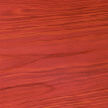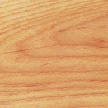Wood Facts

Aromatic Cedar
Color: Mostly red heart wood, thin whitish sapwood
Density: Hard texture Grain: fine grain, very knotty-grain varies around knot
Machinability: Good
Finishing: We suggest using oil finishes that display natural colors.
Distinctive Characteristics: Highly aromatic, natural resistance to insect damage, usually only available in 1” thickness
Common Uses: Cedar chests, closet interiors, furniture interiors
Other Names: Aromatic Red Cedar, Eastern Red Cedar

Ash
Color: Creamy white to light brown heartwood, light sapwood
Density: Very hard, excellent shock resistance
Grain: Distinctive wide-open grain, has occasional brown streaks
Machinability: Very good
Finishing: Takes all finishes well, pigmented stains will bring out the grain nicely.
Distinctive Characteristics: Excellent Oak substitute, “Golden Oak”
Common Uses: Furniture, mouldings, flooring, baseball bats
Other Names: White Ash, Brown Ash, Green Ash

Basswood
Color: Cream to beige color
Density: Very soft texture, like pine, very light in weight, weak strength properties
Grain: Fine, tight grain, non distinctive
Machinability: Excellent
Finishing: Soaks up finish, dark stains will show very dark, light stains will bring out grain.
Distinctive Characteristics: Light weight, cheaply priced substitute for darker woods (Cherry, Walnut, Mahogany) when stained, dimensionally stable after proper drying
Common Uses: Moulding, carving, wood Venetian blinds, core stock for doors and plywoods
Other Names: Linden

Beech
Color: Pink to reddish brown heartwood, sapwood is creamy to pink
Density: Very hard, heavy in weight, excellent shock resistance
Grain: Moderate tight, fine grain with evident flecking at times
Machinability: Machines well at slow speeds, pre drill for nailing and screws
Finishing: Should take a finish well.
Distinctive Characteristics: Very hard, cheaply priced substitute for Oak, Ash,, Hickory, does not impart taste or odor, usually only available in 1”. Very hard to kiln dry properly.
Common Uses: Chair parts, furniture, flooring, food containers, toys, woodenware

Birch
Color: Cinnamon, light reddish brown to pink heartwood, sapwood is creamy-white to yellowish
Density: Hard, medium weight
Grain: Uniform, fine grain, small pores
Machinability: Generally good, some swirled grain will chip out if tooling is not sharp
Finishing: Takes finish very well.
Distinctive Characteristics: Very durable and strong
Common Uses: Cabinets, seating, millwork, furniture, interior doors
Other Names: Our Birch is the specie “Yellow Birch.” There are other Birches (paper, white, or gray).

Black Walnut
Color: Brown to deep purple brown heartwood, sap is brilliant white to cream color-gray
Density: Fairly light weight, medium texture
Grain: Moderately open grain
Machinability: Excellent machining characteristics, turns, sands, and carves well
Finishing: Unsurpassed in finishing! Clear finishes and oils will bring out satiny grain.
Distinctive Characteristics: The dark heartwood makes this very distinctive. Try using pieces with sap mixed with heart.
Common Uses: High end furniture, carving, flooring accents, musical instruments, gun stocks
Other Names: American Black Walnut

Butternut
Color: Tan to brown
Density: Light in weight, not as strong as walnut
Grain: Coarse grained
Machinability: Will machine easily, but has tendency to fuzz up at times
Finishing: Will take finish well, use a sanding sealer.
Distinctive Characteristics: Color and soft texture make this an interesting wood, not always readily available in thicker sizes.
Common Uses: Carvings, some furniture, cabinets, excellent wall paneling
Other Names: White Walnut, Oil Nut

Cherry
Color: Red to deep reddish brown heartwood, white to yellowish sapwood
Density: Medium weight, moderately hard, stiff and strong
Grain: Fine, closed grain
Machinability: Excellent
Finishing: Takes a finish well, however light to natural finishes are recommended.
Distinctive Characteristics: Beautiful markings (gum streaks, pin knots sometimes) and red color will darken to a rich reddish brown with age.
Common Uses: High end furniture, cabinets, interior millwork, musical instruments, paneling, flooring
Other Names: American Black Cherry, Choke Cherry, Rum Cherry, Whiskey Cherry, Wild Cherry
Available in Certified: Check for availability

Curly Cherry
Color: Red to deep reddish brown heartwood, white to yellowish sapwood
Density: Medium weight, moderately hard, stiff and strong
Grain: Wavy patterns running perpendicular to the normal grain orientation
Machinability: Machine slowly to avoid chip out of grain
Finishing: Dark finishes will vary depending on grain orientation of curl (light to dark absorption).
Distinctive Characteristics: This curl is generally not as pronounced as Curly Maple.
Common Uses: High end and period piece furniture, cabinets, interior millwork, musical instruments, paneling, flooring
Other Names: Flame Cherry

Curly Maple
Color: Creamy white to grayish white sapwood, heartwood can be brown to greenish brown with some mineral streaks.
Density: Moderately hard and strong, not quite as strong as Hard Maple.
Grain: Light to very heavy patterns running perpendicular to normal grain orientation
Machinability: Machine slowly to avoid grain chips
Finishing: Dark finishes will vary depending on grain orientation of curl (light to dark absorption).
Distinctive Characteristics: This curl is generally very apparent. The intensity may vary from board to board.
Common Uses: Specialty furniture (Shaker and Mission styles), striking trim, flooring and paneling
Other Names: Flame, Fiddle Back, Tiger Strip (usually denoting the intensity of the pattern)

White Oak
Color: Light tan to brown heartwood, sapwood, sapwood is creamy white to gray
Density: Very hard, shock resistant, and very dense, heavy
Grain: Moderately open grain on plain sawn, Quartered and Rift is straight grain
Machinability: Fairly well, can be tough on tooling
Finishing: Takes a finish well.
Distinctive Characteristics: Highly resistant to the environment, very hard, may be a bit more color consistent than Red Oak. Quartered and Rift sawn have a striking grain appearance.
Common Uses: Barrels, buckets, tool handles, furniture (especially Quartered or Rift grain)
Other Names: Many individual species of Oak fall into the White Oak category.

